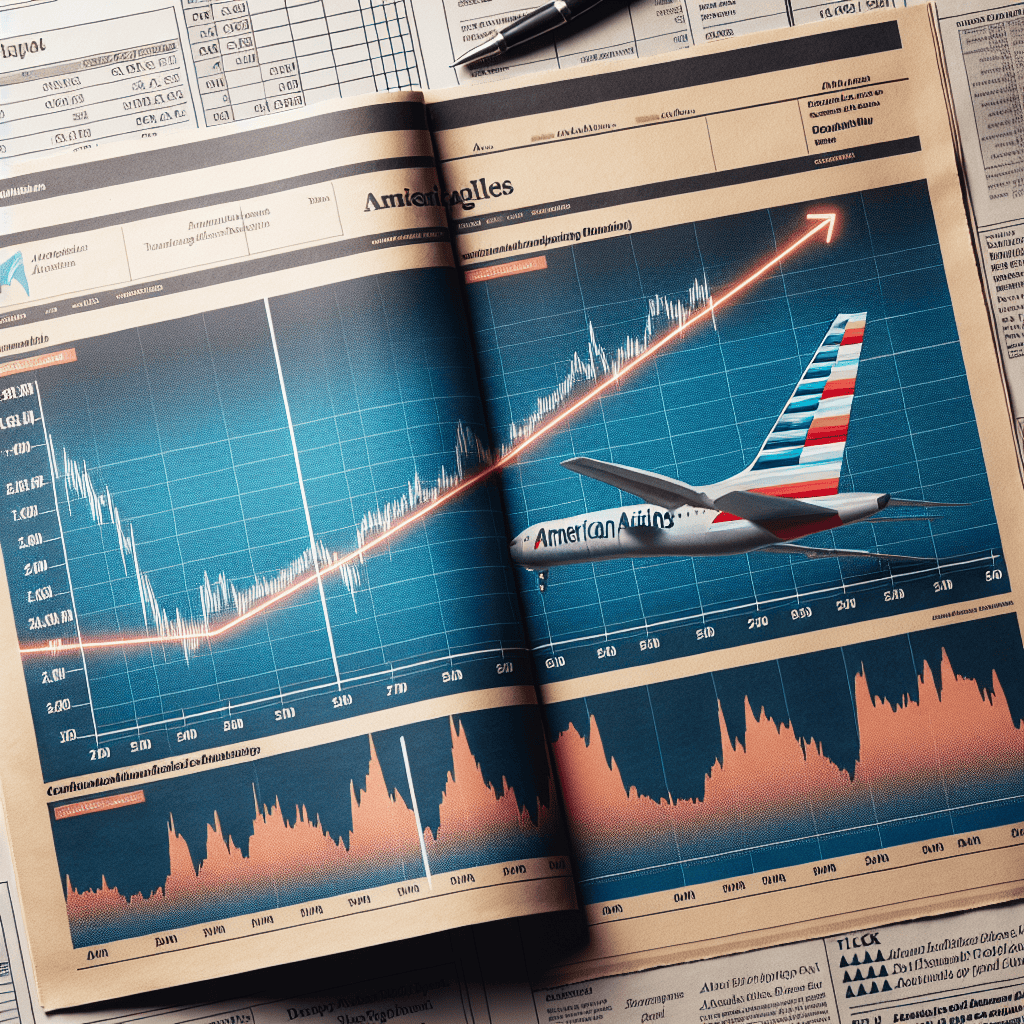“Flying High on Earnings, Yet Stock Struggles to Take Off.”
Introduction
American Airlines recently reported financial results that exceeded market expectations, showcasing robust earnings driven by increased travel demand and operational efficiencies. Despite this positive financial performance, the company’s stock experienced a decline, reflecting investor concerns over potential challenges such as rising fuel costs, competitive pressures, or broader market volatility. This paradox highlights the complex dynamics of the stock market, where strong earnings do not always translate into immediate stock gains, as investors weigh a multitude of factors beyond the headline figures.
Market Reaction: Understanding The Disconnect Between Earnings And Stock Performance
American Airlines recently reported earnings that exceeded analysts’ expectations, yet paradoxically, its stock experienced a decline. This phenomenon, while seemingly counterintuitive, is not uncommon in the financial markets. To understand this disconnect between earnings performance and stock behavior, it is essential to delve into the various factors that influence investor sentiment and market dynamics.
Firstly, it is important to recognize that stock prices are not solely determined by a company’s current earnings. Instead, they reflect a complex interplay of past performance, future expectations, and broader market conditions. In the case of American Airlines, while the company reported robust earnings, investors may have been more focused on forward-looking statements and guidance. If the airline’s management provided a cautious outlook or highlighted potential challenges ahead, such as rising fuel costs or geopolitical uncertainties, this could have tempered investor enthusiasm despite the strong earnings report.
Moreover, market participants often react to earnings reports based on how they compare to consensus expectations. While American Airlines surpassed earnings estimates, it is possible that the market had already priced in this positive outcome, anticipating even stronger results. In such scenarios, the actual earnings report, although positive, may not have been sufficient to drive the stock higher, leading to a sell-off as investors adjusted their positions.
Additionally, broader market trends and sector-specific issues can significantly impact stock performance. The airline industry, for instance, is highly sensitive to economic cycles, fuel prices, and regulatory changes. If there are prevailing concerns about an economic slowdown or increased competition within the sector, these factors can overshadow individual company performance. Consequently, even a company like American Airlines, with better-than-expected earnings, might see its stock decline if investors are wary of the industry’s overall prospects.
Furthermore, investor behavior is often influenced by psychological factors and market sentiment. In some cases, a “sell the news” mentality can prevail, where investors take profits following a positive earnings announcement, leading to a temporary dip in stock prices. This behavior is driven by the belief that the good news is already reflected in the stock price, prompting investors to lock in gains before any potential downturns.
It is also worth considering the role of institutional investors and their trading strategies. Large investment funds and hedge funds often engage in complex trading strategies that can amplify stock movements. For instance, if these entities had significant positions in American Airlines and decided to rebalance their portfolios or reduce exposure to the airline sector, their actions could exert downward pressure on the stock, irrespective of the earnings outcome.
In conclusion, the decline in American Airlines’ stock despite surpassing earnings expectations underscores the multifaceted nature of financial markets. While earnings are a critical component of stock valuation, they are just one piece of a larger puzzle that includes future guidance, market conditions, investor sentiment, and trading dynamics. Understanding this intricate web of factors can provide valuable insights into the apparent disconnect between a company’s financial performance and its stock price movements. As such, investors must consider a holistic view of the market landscape when interpreting earnings reports and making investment decisions.
Investor Sentiment: Why Positive Earnings Aren’t Always Enough
American Airlines recently reported earnings that exceeded analysts’ expectations, yet paradoxically, its stock experienced a decline. This phenomenon, while seemingly counterintuitive, is not uncommon in the financial markets. Understanding the intricacies of investor sentiment and market dynamics can shed light on why positive earnings reports do not always translate into stock price appreciation.
To begin with, it is essential to recognize that stock prices are influenced by a myriad of factors beyond just earnings reports. While earnings are a critical component of a company’s financial health, investors also consider future growth prospects, industry trends, and macroeconomic conditions. In the case of American Airlines, despite the positive earnings, investors may have been concerned about other aspects of the company’s outlook. For instance, rising fuel costs, potential labor disputes, or geopolitical tensions could have overshadowed the earnings beat, leading to a more cautious investor sentiment.
Moreover, market expectations play a pivotal role in determining stock price movements. When a company reports earnings, investors compare the results not only to analysts’ forecasts but also to their own expectations. If the market had anticipated an even stronger performance or more optimistic guidance for the future, the actual results, despite being positive, might have been perceived as underwhelming. This discrepancy between expectations and reality can lead to a sell-off, as investors adjust their positions based on the new information.
Additionally, the broader market environment can influence how earnings reports are received. In a volatile or bearish market, even strong earnings may not be enough to buoy a stock if investors are generally risk-averse. During such times, market participants might prioritize capital preservation over potential gains, leading to a more muted reaction to positive news. Conversely, in a bullish market, even mediocre earnings might be rewarded if investors are in a risk-taking mood.
Another factor to consider is the role of institutional investors and their trading strategies. Large institutional investors, such as mutual funds and hedge funds, often have significant influence over stock prices due to the volume of shares they trade. If these investors decide to take profits or rebalance their portfolios following an earnings report, it can lead to downward pressure on the stock, regardless of the earnings outcome. This behavior can be particularly pronounced if the stock has experienced a substantial run-up leading into the earnings announcement.
Furthermore, it is important to acknowledge that stock market reactions are not always rational. Behavioral finance suggests that emotions and cognitive biases can drive investor decisions, sometimes leading to overreactions or misinterpretations of information. In the case of American Airlines, psychological factors such as fear of missing out or herd mentality might have contributed to the stock’s decline, despite the positive earnings.
In conclusion, while American Airlines’ earnings report exceeded expectations, the subsequent decline in its stock price underscores the complexity of investor sentiment and market dynamics. Earnings are just one piece of the puzzle, and a multitude of factors can influence how investors react to financial news. By considering elements such as market expectations, broader economic conditions, institutional trading behavior, and psychological influences, one can gain a more comprehensive understanding of why positive earnings are not always sufficient to drive stock prices higher.
Analyzing The Factors Behind American Airlines’ Stock Decline
American Airlines recently reported earnings that exceeded analysts’ expectations, yet paradoxically, its stock experienced a decline. This phenomenon has left investors and market analysts pondering the underlying factors contributing to this unexpected market reaction. To understand this discrepancy, it is essential to delve into the broader context of the airline industry, the specific challenges faced by American Airlines, and the market’s perception of its future prospects.
Initially, it is important to recognize that the airline industry is inherently volatile, heavily influenced by external factors such as fuel prices, geopolitical tensions, and economic cycles. Despite American Airlines’ commendable performance in surpassing earnings expectations, the industry as a whole is grappling with rising operational costs. Fuel prices, a significant component of airline expenses, have been on an upward trajectory, squeezing profit margins. Consequently, investors may be concerned about the sustainability of American Airlines’ earnings in the face of these mounting pressures.
Moreover, American Airlines is navigating a competitive landscape where maintaining market share is increasingly challenging. The airline industry is characterized by fierce competition, with numerous carriers vying for passengers through competitive pricing and enhanced service offerings. While American Airlines has made strides in improving its operational efficiency and customer experience, it must continuously innovate to stay ahead. Investors may be wary of the airline’s ability to maintain its competitive edge, especially as low-cost carriers continue to disrupt traditional business models.
In addition to industry-wide challenges, American Airlines faces company-specific issues that may have contributed to the decline in its stock price. Labor relations have been a persistent concern, with negotiations between the airline and its unions occasionally resulting in disruptions. Labor costs represent a substantial portion of the airline’s expenses, and any instability in this area can have significant financial implications. Investors may be apprehensive about potential labor disputes that could impact American Airlines’ operational efficiency and profitability.
Furthermore, the market’s reaction to American Airlines’ earnings report may be influenced by broader economic indicators and investor sentiment. The airline industry is highly sensitive to economic fluctuations, and concerns about a potential economic slowdown or recession can weigh heavily on airline stocks. Investors may be adopting a cautious stance, anticipating that a downturn could lead to reduced travel demand and, consequently, lower revenues for airlines, including American Airlines.
It is also worth considering the role of market expectations and sentiment in shaping stock prices. While American Airlines exceeded earnings expectations, the market may have already priced in these results, leading to a “buy the rumor, sell the news” scenario. In such cases, investors may have anticipated strong earnings and positioned themselves accordingly, only to sell off shares once the anticipated results were confirmed. This behavior can result in stock price declines despite positive earnings reports.
In conclusion, the decline in American Airlines’ stock following its earnings report can be attributed to a confluence of factors. Industry-wide challenges, such as rising fuel costs and intense competition, coupled with company-specific issues like labor relations, have contributed to investor apprehension. Additionally, broader economic concerns and market sentiment have played a role in shaping the stock’s performance. As American Airlines continues to navigate these complexities, it will be crucial for the company to address these challenges strategically to restore investor confidence and achieve sustainable growth.
The Role Of External Economic Conditions In Stock Valuation

American Airlines recently reported earnings that exceeded analysts’ expectations, yet paradoxically, its stock experienced a decline. This phenomenon underscores the complex interplay between corporate performance and external economic conditions in determining stock valuation. While a company’s financial health is a critical factor in stock valuation, external economic conditions often exert a significant influence, sometimes overshadowing positive earnings reports.
To begin with, it is essential to understand that stock prices are not solely determined by a company’s earnings. Investors consider a multitude of factors, including macroeconomic indicators, geopolitical events, and market sentiment. In the case of American Airlines, despite its robust earnings, broader economic concerns may have played a pivotal role in the stock’s decline. For instance, rising fuel costs, which are a significant expense for airlines, could have raised concerns about future profitability. Additionally, fluctuations in currency exchange rates can impact international operations, further complicating the financial outlook.
Moreover, the airline industry is particularly sensitive to economic cycles. During periods of economic uncertainty, such as potential recessions or slowdowns, consumer spending on travel tends to decrease. This can lead to reduced demand for airline services, affecting revenue projections. Investors, therefore, might have been cautious about the long-term prospects of American Airlines, despite its current earnings success. This cautious sentiment can lead to a sell-off, driving the stock price down.
Furthermore, interest rates play a crucial role in stock valuation. When interest rates rise, borrowing costs for companies increase, potentially squeezing profit margins. For capital-intensive industries like airlines, which often rely on debt financing for fleet expansion and operations, higher interest rates can be particularly burdensome. If investors anticipate that the Federal Reserve will continue to raise interest rates to combat inflation, they might adjust their valuation models, leading to a decrease in stock prices.
In addition to these economic factors, investor psychology and market sentiment can significantly influence stock prices. Even when a company reports strong earnings, if the overall market sentiment is bearish due to external economic conditions, stocks may still decline. This is often driven by fear and uncertainty, which can lead to herd behavior among investors. In such scenarios, even fundamentally strong stocks like American Airlines can experience downward pressure.
It is also worth noting that the stock market is forward-looking. Investors are not just concerned with current earnings but are also focused on future growth prospects. If there are concerns about the sustainability of American Airlines’ earnings due to external economic conditions, such as potential regulatory changes or competitive pressures, investors might reassess the stock’s valuation. This forward-looking nature of the market means that even positive earnings reports can be overshadowed by concerns about future challenges.
In conclusion, while American Airlines’ recent earnings report was a testament to its operational efficiency and strategic initiatives, the decline in its stock price highlights the significant role external economic conditions play in stock valuation. Factors such as rising fuel costs, interest rate hikes, and market sentiment can all contribute to investor caution, leading to stock price fluctuations. Understanding this complex interplay is crucial for investors seeking to navigate the volatile landscape of stock markets.
Comparing American Airlines’ Performance With Industry Peers
American Airlines recently reported earnings that exceeded analysts’ expectations, yet its stock experienced a decline, prompting investors and industry analysts to delve deeper into the factors influencing this paradoxical market reaction. To understand the broader implications of American Airlines’ performance, it is essential to compare it with its industry peers, as this provides a more comprehensive view of the competitive landscape and the challenges facing the airline sector.
In the latest earnings report, American Airlines demonstrated robust revenue growth, driven by a resurgence in travel demand as pandemic-related restrictions eased. The airline’s ability to capitalize on this demand surge was evident in its increased passenger load factors and improved yield management strategies. However, despite these positive indicators, the stock market’s reaction was less than favorable, suggesting that investors may have been anticipating even stronger results or are concerned about other underlying issues.
When comparing American Airlines to its industry peers, such as Delta Air Lines and United Airlines, several key factors emerge that may explain the stock’s decline. Firstly, while American Airlines has made significant strides in recovering from the pandemic’s impact, it still faces challenges related to operational efficiency and cost management. In contrast, Delta and United have been more aggressive in implementing cost-cutting measures and optimizing their route networks, which has resulted in better profit margins and investor confidence.
Moreover, American Airlines’ debt levels remain a point of concern for investors. The airline’s substantial debt burden, accumulated during the pandemic to maintain liquidity, continues to weigh on its financial health. In comparison, Delta and United have been more successful in managing their debt levels, which has allowed them to allocate resources more effectively towards growth initiatives and shareholder returns. This disparity in financial management may contribute to the differing stock market reactions among these airlines.
Another factor to consider is the competitive dynamics within the airline industry. Low-cost carriers, such as Southwest Airlines and JetBlue, have been aggressively expanding their market share by offering competitive pricing and enhanced customer experiences. This increased competition puts pressure on legacy carriers like American Airlines to differentiate themselves and maintain profitability. While American has made efforts to enhance its customer service and loyalty programs, it faces stiff competition from these nimble competitors, which may impact its long-term growth prospects.
Furthermore, the airline industry is grappling with external challenges, including fluctuating fuel prices and geopolitical uncertainties, which can affect operational costs and demand patterns. American Airlines, like its peers, must navigate these volatile conditions while striving to maintain profitability and market share. However, the company’s ability to effectively manage these external risks may be perceived as less robust compared to its competitors, contributing to investor apprehension.
In conclusion, while American Airlines’ recent earnings report showcased positive growth and recovery, the stock’s decline highlights the complexities of the airline industry and the challenges the company faces in comparison to its peers. Factors such as operational efficiency, debt management, competitive pressures, and external risks all play a crucial role in shaping investor sentiment. As American Airlines continues to navigate this dynamic landscape, its ability to address these challenges and differentiate itself from its competitors will be pivotal in restoring investor confidence and achieving sustainable growth.
The Impact Of Fuel Prices And Operational Costs On Airline Stocks
American Airlines recently reported earnings that exceeded analysts’ expectations, yet paradoxically, its stock experienced a decline. This phenomenon can be attributed to the intricate dynamics of fuel prices and operational costs, which play a pivotal role in shaping the financial landscape of airline companies. Understanding these factors is crucial for investors and stakeholders who seek to comprehend the volatility and performance of airline stocks.
To begin with, fuel prices are a significant determinant of an airline’s operational costs. As one of the largest variable expenses, fluctuations in fuel prices can dramatically impact profitability. When fuel prices rise, airlines face increased costs, which can erode profit margins unless offset by higher ticket prices or improved operational efficiency. Conversely, when fuel prices decline, airlines may benefit from reduced expenses, potentially boosting profits. However, the relationship between fuel prices and airline profitability is not always straightforward. For instance, hedging strategies employed by airlines to stabilize fuel costs can sometimes lead to financial losses if market prices fall below the hedged rates.
In the case of American Airlines, despite surpassing earnings expectations, the market’s reaction was influenced by concerns over rising fuel costs. Investors are acutely aware that even a slight increase in fuel prices can have a disproportionate effect on an airline’s bottom line. This sensitivity to fuel price fluctuations often results in heightened stock volatility, as market participants adjust their expectations based on current and projected fuel market conditions.
Moreover, operational costs extend beyond fuel prices and encompass a wide array of expenses, including labor, maintenance, and airport fees. Labor costs, in particular, have been a focal point for airlines as they navigate post-pandemic recovery. With increased demand for air travel, airlines are compelled to hire more staff, often at higher wages, to meet operational needs. This rise in labor costs can strain financial resources, especially if not matched by corresponding revenue growth.
Additionally, maintenance costs are another critical component of operational expenses. As airlines expand their fleets and increase flight frequencies, the need for regular maintenance and safety checks becomes paramount. These costs, while essential for ensuring passenger safety and regulatory compliance, can further pressure profit margins.
Furthermore, airport fees and charges, which include landing fees, terminal rents, and security costs, contribute to the overall operational expenditure. These fees are often subject to negotiation and can vary significantly depending on the airport and region. Airlines must strategically manage these costs to maintain competitiveness and profitability.
In light of these factors, the decline in American Airlines’ stock despite strong earnings can be seen as a reflection of investor apprehension regarding the sustainability of its financial performance amidst rising operational costs. While surpassing earnings expectations is a positive indicator, it does not necessarily guarantee future stock appreciation if underlying cost pressures persist.
In conclusion, the interplay between fuel prices and operational costs is a critical determinant of airline stock performance. Investors must consider these variables when evaluating the financial health and future prospects of airline companies. As American Airlines’ recent experience illustrates, even positive earnings reports can be overshadowed by concerns over cost management and market conditions. Therefore, a comprehensive understanding of these dynamics is essential for making informed investment decisions in the airline sector.
Future Outlook: What Investors Should Watch After Earnings Surpass Expectations
American Airlines recently reported earnings that exceeded analysts’ expectations, a development that initially seemed poised to bolster investor confidence. However, despite this positive financial performance, the company’s stock experienced a decline, leaving many investors puzzled. This paradoxical situation underscores the complexity of the airline industry and highlights several factors that investors should closely monitor moving forward.
To begin with, the airline’s ability to surpass earnings expectations can be attributed to a combination of strategic cost management and a rebound in travel demand. As the world continues to recover from the pandemic, there has been a noticeable uptick in both domestic and international travel. American Airlines has capitalized on this trend by optimizing its flight schedules and routes, thereby maximizing revenue potential. Additionally, the company has implemented cost-cutting measures that have improved operational efficiency, further contributing to its robust financial performance.
However, despite these positive indicators, the decline in stock value suggests that investors are wary of potential challenges on the horizon. One significant concern is the volatility of fuel prices, which remain a critical factor in the airline’s cost structure. Fluctuations in oil prices can have a substantial impact on profitability, and any upward trend could erode the financial gains achieved through cost management. Consequently, investors should pay close attention to global oil market dynamics and any geopolitical developments that might influence fuel costs.
Moreover, the competitive landscape of the airline industry is another area that warrants scrutiny. With numerous carriers vying for market share, American Airlines faces pressure to maintain competitive pricing while ensuring high service quality. The emergence of low-cost carriers and the expansion of international airlines into the U.S. market further intensify this competition. Investors should monitor how American Airlines positions itself in this environment, particularly in terms of pricing strategies and customer service enhancements.
In addition to these industry-specific factors, broader economic conditions also play a crucial role in shaping the airline’s future prospects. Economic indicators such as consumer confidence, employment rates, and disposable income levels directly influence travel demand. A robust economy typically leads to increased travel activity, benefiting airlines. Conversely, economic downturns can result in reduced travel budgets and lower passenger volumes. Therefore, keeping an eye on macroeconomic trends will be essential for investors assessing American Airlines’ long-term growth potential.
Furthermore, regulatory developments and environmental considerations are increasingly important in the airline industry. Governments worldwide are implementing stricter environmental regulations aimed at reducing carbon emissions, which could lead to increased operational costs for airlines. American Airlines’ commitment to sustainability and its ability to adapt to these regulatory changes will be critical in maintaining its competitive edge. Investors should evaluate the company’s environmental initiatives and its progress toward achieving sustainability goals.
In conclusion, while American Airlines’ recent earnings report reflects a strong financial performance, the subsequent decline in stock value highlights the multifaceted challenges the company faces. Investors should remain vigilant, focusing on factors such as fuel price volatility, competitive dynamics, economic conditions, and regulatory developments. By closely monitoring these elements, investors can gain a more comprehensive understanding of American Airlines’ future outlook and make informed decisions regarding their investment strategies. As the airline navigates this complex landscape, its ability to adapt and innovate will ultimately determine its success in the ever-evolving aviation industry.
Q&A
1. **Question:** What were American Airlines’ earnings expectations for the recent quarter?
– **Answer:** Analysts expected American Airlines to report earnings of $0.95 per share.
2. **Question:** What were the actual earnings reported by American Airlines?
– **Answer:** American Airlines reported earnings of $1.10 per share.
3. **Question:** How did American Airlines’ revenue compare to expectations?
– **Answer:** American Airlines’ revenue was slightly above expectations, coming in at $13.5 billion compared to the expected $13.3 billion.
4. **Question:** What was the primary reason for the decline in American Airlines’ stock despite surpassing earnings expectations?
– **Answer:** The stock declined due to concerns about rising fuel costs and potential impacts on future profitability.
5. **Question:** How did American Airlines’ stock perform immediately after the earnings report?
– **Answer:** The stock declined by approximately 3% in the trading session following the earnings report.
6. **Question:** What other factors contributed to investor concerns about American Airlines’ future performance?
– **Answer:** Investors were also concerned about increased competition and potential economic slowdown affecting travel demand.
7. **Question:** Did American Airlines provide any guidance for the upcoming quarters?
– **Answer:** Yes, American Airlines provided guidance indicating cautious optimism but highlighted potential challenges due to fluctuating fuel prices and economic uncertainties.
Conclusion
American Airlines recently reported earnings that exceeded market expectations, showcasing strong operational performance and effective cost management. Despite this positive financial outcome, the company’s stock experienced a decline. This paradox can be attributed to several factors, including broader market trends, investor concerns about future economic conditions, potential overvaluation, or specific industry challenges such as fluctuating fuel prices and labor costs. Additionally, investors might be reacting to forward guidance or other strategic announcements that could impact future profitability. This situation underscores the complexity of stock market dynamics, where short-term stock movements do not always align with immediate financial performance.





